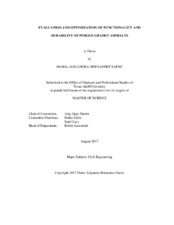| dc.description.abstract | Porous Graded Asphalts (PGA) are thin layers utilized on top of conventional pavements that are characterized for containing high air void contents (AV) (usually larger than 18%) which results in high drainability; this provides safety conditions since it reduces hydroplaning, splash and spray and glare at night and improves skid resistance and the visibility of pavement markings along with some environmental and driving enhancements. An ideal PGA should achieve a balance between functionality (i.e., the capacity of maintaining the beneficial properties throughout the service life) and durability (i.e., the resistance to distress and/or failure); however, some transportation agencies have reported highly functional PGA mixtures with early failures, or highly durable mixtures that do not achieve long-term beneficial properties.
In order to overcome this problem, an assessment of the durability and functionality of four different PGA materials was performed. Durability was evaluated via Cantabro loss test, Hamburg Wheel Track test (HWTT), Semi Circular Bending test (SCB) and Indirect Tensile Strength/ Tensile Strength Ratio test (IDT/TSR). Functionality was evaluated via permeability test with TXDOT, NCAT and FDOT permeameters and noise absorption was evaluated using the Impedance Tube test. Additionally, construction and maintenance specifications were revised in order to identify key procedures to guarantee adequate functionality and durability of PGA.
It was found that the functionality of the mixture is best represented by the permeability measurements which depend crucially on the AV, thickness and type of permeameter utilized. Durability of the mixture was better represented by the Cantabro loss test, HWTT and SCB are not recommended; the Cantabro loss depends significantly on the AV, type of conditioning protocol and thickness. It was found that increasing the AV increases the permeability, which is beneficial for functionality, but at the same time the Cantabro resistance decreases, which translates to a greater potential for abrasion related regardless of the thickness or type of material. Hence it is suggested to do an optimization and include it in PGA specifications with both minimum and maximum AV thresholds guaranteeing functional mixtures that perform adequately over the service life. | en |


